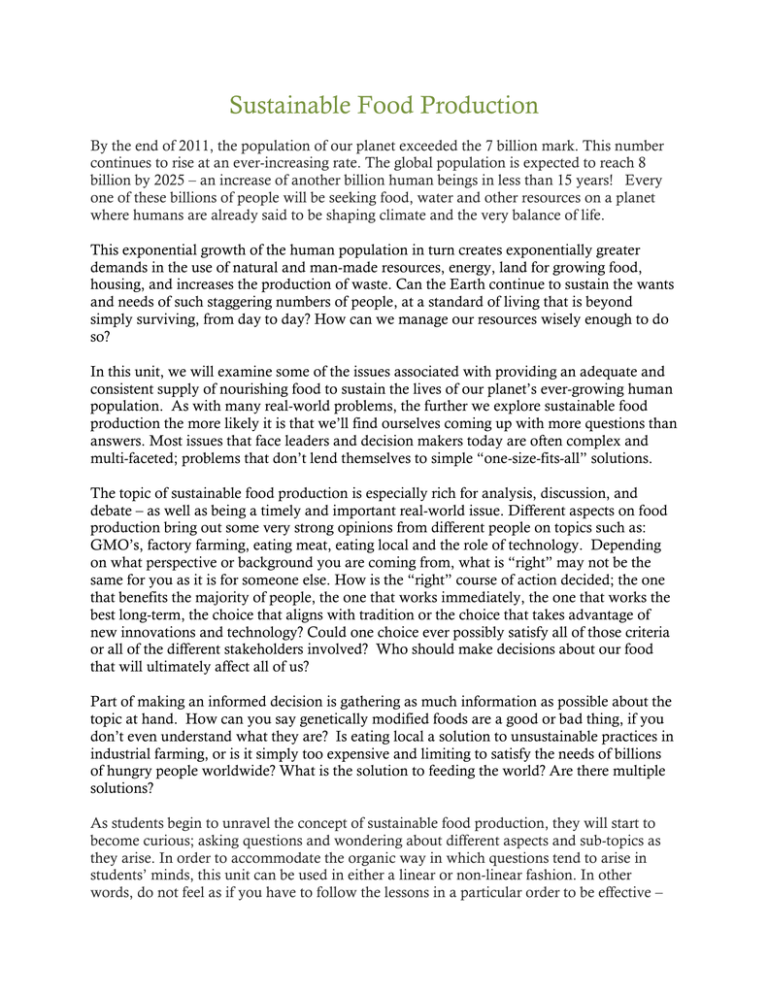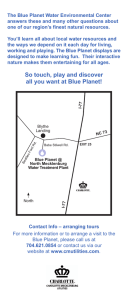Sustainable Food Production
advertisement

Sustainable Food Production By the end of 2011, the population of our planet exceeded the 7 billion mark. This number continues to rise at an ever-increasing rate. The global population is expected to reach 8 billion by 2025 – an increase of another billion human beings in less than 15 years! Every one of these billions of people will be seeking food, water and other resources on a planet where humans are already said to be shaping climate and the very balance of life. This exponential growth of the human population in turn creates exponentially greater demands in the use of natural and man-made resources, energy, land for growing food, housing, and increases the production of waste. Can the Earth continue to sustain the wants and needs of such staggering numbers of people, at a standard of living that is beyond simply surviving, from day to day? How can we manage our resources wisely enough to do so? In this unit, we will examine some of the issues associated with providing an adequate and consistent supply of nourishing food to sustain the lives of our planet’s ever-growing human population. As with many real-world problems, the further we explore sustainable food production the more likely it is that we’ll find ourselves coming up with more questions than answers. Most issues that face leaders and decision makers today are often complex and multi-faceted; problems that don’t lend themselves to simple “one-size-fits-all” solutions. The topic of sustainable food production is especially rich for analysis, discussion, and debate – as well as being a timely and important real-world issue. Different aspects on food production bring out some very strong opinions from different people on topics such as: GMO’s, factory farming, eating meat, eating local and the role of technology. Depending on what perspective or background you are coming from, what is “right” may not be the same for you as it is for someone else. How is the “right” course of action decided; the one that benefits the majority of people, the one that works immediately, the one that works the best long-term, the choice that aligns with tradition or the choice that takes advantage of new innovations and technology? Could one choice ever possibly satisfy all of those criteria or all of the different stakeholders involved? Who should make decisions about our food that will ultimately affect all of us? Part of making an informed decision is gathering as much information as possible about the topic at hand. How can you say genetically modified foods are a good or bad thing, if you don’t even understand what they are? Is eating local a solution to unsustainable practices in industrial farming, or is it simply too expensive and limiting to satisfy the needs of billions of hungry people worldwide? What is the solution to feeding the world? Are there multiple solutions? As students begin to unravel the concept of sustainable food production, they will start to become curious; asking questions and wondering about different aspects and sub-topics as they arise. In order to accommodate the organic way in which questions tend to arise in students’ minds, this unit can be used in either a linear or non-linear fashion. In other words, do not feel as if you have to follow the lessons in a particular order to be effective – choose the lessons as the topics come up naturally with your students! The following graphic is a concept map of topics contained in this unit. As you can see, the topics naturally connect to each other in a web form, much more so than as an outline or list. For example, beginning with an exploration of the scale of billions of people could lead students to wonder about a multitude of different topics related to food production. Start with what the students are interested in! Many of these topics will eventually lead to one another as the students explore. Not only are the topics interconnected, many of them allow opportunities for much deeper research and content-specific learning. If a student is particularly interested in the science of genetics after learning about genetically modified foods, then let that student choose to go deeper into that area, while another student may be more interested in the local food movement in your area. Do not feel locked into presenting each lesson as a whole-class activity. Every student may enjoy extracting strawberry DNA, but only some may want to continue to research genetics beyond the expectation for the unit. While these students use online resources to continue researching about genetics, other students may be much more interested in creating seasonal menus from locally available produce and another group of students might want to set up an experiment to compare the mold rates of various fast food hamburgers…let your students find their passions and delve deeper! Some of the lessons, such as the lesson about conceptualizing the scale of a million or a billion people are best done as a whole group. Others, such as the lessons about GMO’s, can be started with the whole group and then transition to letting students work individually or in small groups to complete a project to share with the class. This lets the students learn at their own pace, delve deeper into topics they are particularly interested in and produce a product that is meaningful to them in the process. Access to technology is key in many of these lessons. Several of them integrate online videos, readings and interactive learning resources. There are many useful websites listed, but there are many others available beyond the ones that are mentioned. There are also some not-so-good websites out there too, unfortunately. Discerning valid information from misinformation is truly a necessary skill for anyone doing research – especially when doing online research. Take time to discuss with students cross-referencing information, understanding bias and the importance of citing sources. Authentic assessments for student learning include not only content knowledge but process skills as well. It isn’t just about having them show what they know, but also about having them create meaningful projects and presentations to share with their classmates; products that mirror tasks performed in the work world by career professionals. Sustainability Model Before beginning the lessons in this unit, take time to share and discuss the Sustainability Model with them. What do they think each of these categories: Economic, Environment and Social mean? If you replaced the words: Economic = Profit, Environment = Planet, and Social = People, does it change their perspective? Is one realm more important than the others? Should one realm be more important? What examples from life can they give that fall into the categories of Bearable, Viable and Equitable? (For example: Everyone on the planet has his/her own car to drive – equitable, but maybe not environmentally sound?)





